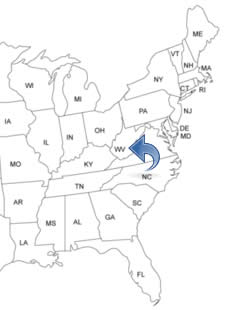WEST VIRGINIA PEOPLE SEARCH!
- ✔ Contact Info
- ✔ Phone Numbers
- ✔ Criminal Records
- ✔ Income Info
- ✔ Neighbors
- ✔ People's Age
- ✔ Property Ownership
- ✔ And Much More
Charleston, West Virginia
Charleston is located in the western part and is the capital and the largest city in the U.S. State of West Virginia. The City of Charleston is home to many cultural and recreational attractions. The city is the cultural, recreational, and business capital of the Appalachian Mountains. The city has many historic buildings and about fifty places are on the National Register of Historic Places. The Kanawha Forest offers nearly 10,000 acres of exploration and recreation just south of Charleston.
To See And To Do In Charleston
- West Virginia Culture Center
- Kanawha State Forest
- Charleston Town Center Mall
- Avampato Discovery Museum
- St. George Orthodox Cathedral
- Magic Island
- The West Virginia State Capitol
History Of Charleston - Timeline
In 1770, Colonel Samuel Washington built a house in the area. In 1787/1788, Fort Lee was built by Colonel Savannah Clendenin. It was the first permanent settlement in today's Charleston.
In 1794, Charleston was established as Charles Town and there were now seven houses in the town. Savannah Clendenin father's name was Charles and historical conjecture indicates that Charles Town was named after him.
In 1806, salt brines had been discovered and the first salt well drilled. In 1815, natural gas was discovered when Captain James Wilson was drilling for salt. Also in 1815, Daniel Ruffner built a brick house, the Ruffner Mansion, also known as Holly Grove Mansion.
In 1818, Charles Town was renamed Charleston. In 1820, the first newspaper, the Kanawha Spectator, was published in the town. In 1834, the Craik-Patton House was built on Virginia Street. (The house was moved to Roadside Park 1973).
In 1836, Norris Whitteker built the MacFarland House. Henry MacFarland (who was a merchant) and Julia MacFarland lived there. In 1845, the Littlepage Stone Mansion was built. In 1847, the William S. Gilliland Log Cabin and Cemetery was built by one of Charleston's oldest families, the Gillilands.
In 1862, the town was occupied by the Confederate States Army for six weeks before the Union troops returned and stayed through the end of the war. In 1865, the first free public school opened. In 1870, Charleston was incorporated as a city and the State Capitol moved from Wheeling to Charleston.
In 1873, the newspaper Kanawha Chronicle was founded, today's Charleston Gazette, and Ernest Porterfield became a police officer. He was the first black police officer. In 1883, telephones were installed in the city. In 1884, the St. John's Episcopal Church was built.
In 1885, the city became the permanent state capital. In 1888, the University of Charleston opened. In 1892, the Kanawha County Courthouse was completed. In 1896, rural free mail delivery began.
In 1900, over 11,000 people were living in the city. In 1905, the Charleston Amtrak Station opened. In 1912, the Plaza Theatre opened. In 1916, the Charleston High School opened. (Closed 1989). In 1918, a fire destroyed the Charleston Gazette building.
In 1921, the State Capitol was destroyed by a fire. Also in 1921, the radio station WOBU started. (Today's WCHS). In 1923, the Charleston Catholic High School was established. In 1922, the Charleston Baptist Temple was built. In 1925, the new West Virginia State Capitol was built. In 1927, the Daniel Boone Hotel opened.
In 1929, American composer of contemporary classical music, George Crumb, was born. In 1954, WCHS-TV started airing an analog signal on VHF channel 8. In 1964, the George Washington High School was established. In 1983, the Charleston Town Center opened.

